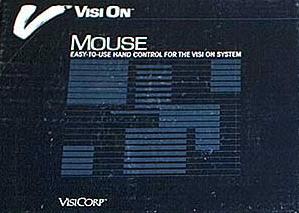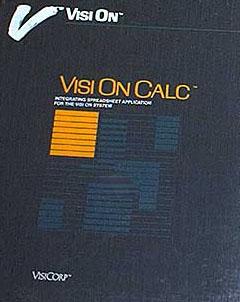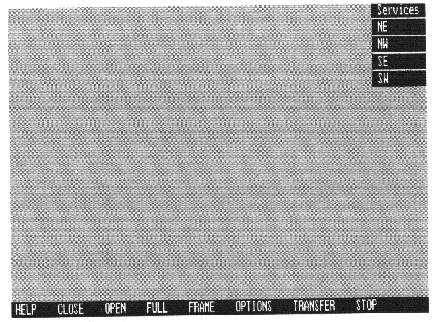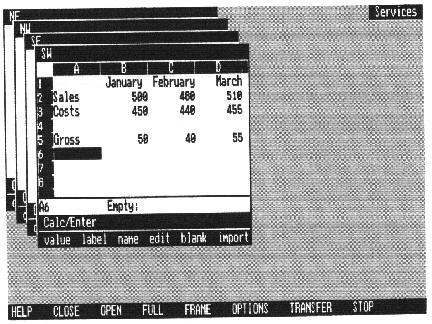
The VisiOn system consists of the system Applications Manager, a pointing device (mouse),

and application programs (spreadsheet, graph, word processor, data
base).
The VisiOn system provides a natural framework for application programs.
Several applications can be on your screen at once, all can exchange
data with each other.

A typical hardware setup includes a personal computer with 256K or
more of random access memory, a 5 megabytes or more hard disk, a graphics
display, a printer, and a mouse. In addition, the system must include a
floppy disk drive.
***
VisiOn environment
Any bordered rectangular area on the screen is known as a WINDOW.
You can close a window at any time with the close command and
reopen it with the open command.
After you close a window, its name appears in the upper right corner
of the screen.
The window contents remain available to you at any time. Reopen the
window by pointing to it and pushing select with the mouse pointer.

Electronic desktop with closed windows
You can put a window anywhere on the screen.
To control its size, you use the frame command.
When you want a window to occupy the entire screen, use the full
command.
All windows have three areas.
Top - gives the windows's title.
Middle - the largest area, displays your spreadsheets, graph,
word-processing, database.
Bottom - has a dialogue area.
Use the dialogue area to control the application program by using its
commands to work with the program.
The scrolling button - located on the pointing device, lets
you view the entire document by moving it up, down, left, and right.

Electronic desktop with four open windows
***
Click here for more pictures
***
October 1983 VisiCorp releases VisiOn, an "integrated environment"
that's the first GUI for the PC.
To work well it requires 512K of RAM and a hard disk--still a cutting-edge
setup at this point.
VisiOn software series was sold August 07, 1984 to Control Data
Corp. for a reported $2.5 million dollars.
Not long after this, Quarterdeck Software announced it's plans to market
DESQ
for the IBM. There was a race on, and for once in his life, Bill Gates
was well behind the pack. A decision was made to announce Microsoft Windows.
Gates set an initial release date for May of 1984. Microsoft already had
considerable weight in the PC industry, since it's MS-DOS operating system
was standard for nearly all IBM PCs. In addition, many hardware vendors
sought to ally themselves with Microsoft to prevent a monopoly of the market
by IBM.
The Microsoft announcement resulted in commitments from hardware vendors
to support the Windows concept. This meant the Microsoft would have a significant
edge over competing GUI's, since hardware vendors have a great influence
on the software purchases of PC buyers. Never the less, software vendors
pushed on with their own versions of GUIs. IBM chose to support VisiON,
and in early 1984, IBM released several major applications for the VisiOn
product. By that time it was clear to Bill Gates that Windows would not
be ready by May. He announced that MS-DOS 3.0 would contain a GUI environment.
Since DOS 3.0 was to be released very soon, users and vendors heaved a
sigh of relief. But when DOS 3.0 came out, it had none of the promised
features. The release date for Windows was pushed back to August, and the
PC world was outraged.
The Windows development team suffered further setbacks when it was
determined that existing hardware standards did not include enough memory
to run the Windows system. This, in conjunction with organizational problems,
pushed the release date all the way back to June of 1985.
This allowed Microsoft's competitors a huge advantage. DESQ
was on the market, and IBM released TopView.
Fortunately for Microsoft, these applications were not well received. Another
near fatal blow to the Windows project occurred when Digital Research released
their GEM windowing system. It was so close to the
Macintosh interface that is sold like hotcakes.
Over 150,000 were sold in the early months of release. But Microsoft
was to luck out again.
The folks over at Apple decided that the GEM
interface was just a little too close to the Macintosh interface and threatened
a lawsuit. Digital Research pulled the product to rewrite the interface.
Windows could still find room in the market. Windows was finally released
in November of 1985, a full two years after it had been announced. It was
not initially well received by the public or by the PC vendors who were
initially committed to it's support. Apple didn't like it either.
As they had done with GEM, they threatened to
file a lawsuit against Microsoft for copyright infringement. But Bill Gates
would have none of that. Microsoft software such as MS-Word and Excel boosted
Macintosh sales, and Bill Gates knew it.
He threatened to no longer support those products if Apple pursued
the lawsuit. This soured relations between the two companies, but it was
enough to get Apple to delay their plans to sue long enough for Windows
to get a foothold in the GUI market.
![]()
pcbiography.net